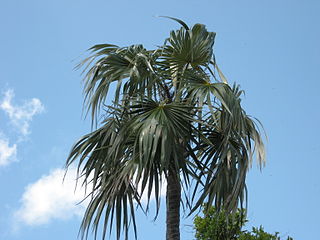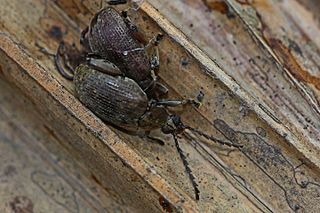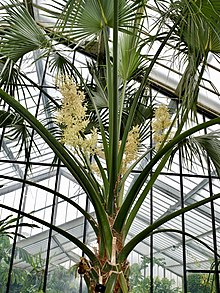
Serenoa repens, commonly known as saw palmetto, is the sole species currently classified in the genus Serenoa. It is a small palm, growing to a maximum height around 7–10 ft (2.1–3.0 m). It is endemic to the subtropical Southeastern United States, most commonly along the south Atlantic and Gulf Coastal plains and sand hills. It grows in clumps or dense thickets in sandy coastal areas, and as undergrowth in pine woods or hardwood hammocks.

Sabal is a genus of palms endemic to the New World. Currently, there are 17 recognized species of Sabal, including one hybrid species. The species are native to the subtropical and tropical regions of the Americas, from the Gulf Coast/South Atlantic states in the Southeastern United States, south through the Caribbean, Mexico, and Central America to Colombia and Venezuela. Members of this genus are typically identified by the leaves which originate from a bare, unarmed petiole in a fan-like structure. All members of this genus have a costa that extends into the leaf blade. This midrib can vary in length; and it is due to this variation that leaf blades of certain species of Sabal are strongly curved or strongly costapalmate or weakly curved, weakly costapalmate,. Like many other palms, the fruit of Sabal are drupe, that typically change from green to black when mature.

The Palmetto is a passenger train operated by Amtrak on a 829-mile (1,334 km) route between New York City and Savannah, Georgia, via the Northeast Corridor, Washington, D.C., Richmond, Virginia, Fayetteville, North Carolina, and Charleston, South Carolina. The Palmetto is a shorter version of the Silver Meteor, which continues south to Miami, Florida. Between 1996 and 2002 this service was called the Silver Palm. Although currently a day train, in the past the Palmetto provided overnight sleeper service to Florida.

Heart of palm is a vegetable harvested from the inner core and growing bud of certain palm trees, most notably the coconut, juçara, açaí palm, palmetto, and peach palm. Harvesting of many uncultivated or wild single-stemmed palms results in palm tree death. However, other palm species are clonal or multi-stemmed plants and moderate harvesting will not kill the entire clonal palm. Heart of palm may be eaten on its own, and often it is eaten in a salad.

Sabal minor, commonly known as the dwarf palmetto, is a small species of palm. It is native to the deep southeastern and south-central United States and northeastern Mexico. It is naturally found in a diversity of habitats, including maritime forests, swamps, floodplains, and occasionally on drier sites. It is often found growing in calcareous marl soil. Sabal minor is one of the most frost and cold tolerant among North American palms.

The Great Seal of the State of Florida is used to represent the government of the state of Florida, and for various official purposes, such as to seal official documents and legislation. It is commonly used on state government buildings, vehicles and other effects of the state government. It also appears on the state flag of Florida. The University of Florida was bestowed the honor of using the seal as its university seal.

Washington Oaks Gardens State Park is a Florida State Park located near Palm Coast, Florida, along A1A. The park is most famous for its formal gardens, but it also preserves the original habitat of a northeast Florida barrier island.

Coccothrinax argentata, commonly called the Florida silver palm, is a species of palm tree. It is native to south Florida, southeast Mexico, Colombia and to the West Indies, where it is found in the Bahamas, the southwest Caribbean and the Turks and Caicos Islands. Its natural habitat is rocky, calcareous soil in coastal scrubland and hammock communities.

Sabal bermudana, commonly known as the Bermuda palmetto or bibby-tree, is one of 15 species of palm trees in the genus Sabal and is endemic to Bermuda although reportedly naturalized in the Leeward Islands. It was greatly affected by the introduction of non-native plants such as the Chinese fan palm, which created competition for space that it usually lost.

Sabal palmetto, also known as cabbage palm, cabbage palmetto, sabal palm, blue palmetto, Carolina palmetto, common palmetto, Garfield's tree, and swamp cabbage, is one of 15 species of palmetto palm. It is native to the Southern United States, as well as Cuba, the Turks and Caicos Islands, and the Bahamas.

Illicium parviflorum, commonly known as yellow anisetree, yellow-anise, swamp star-anise, and small anise tree, is a species of flowering plant in the family Schisandraceae, or alternately, the Illiciaceae. It is native to Florida in the United States. It historically occurred in Georgia as well, but it has been extirpated from the state.

Sabal causiarum, commonly known as the Puerto Rico palmetto or Puerto Rican hat palm, is a species of palm which is native to Hispaniola, Puerto Rico, and the British Virgin Islands. As its common and scientific names suggest, its leaves are used in the manufacture of "straw" hats.

Sabal etonia, commonly known as the scrub palmetto is a species of palm. It is native only to peninsular Florida in the United States, where it is found in Florida sand pine scrub communities.
Texas Phoenix palm decline, or lethal bronzing, is a plant disease caused by a phytoplasma, Candidatus Phytoplasma palmae. It takes its name from the state it was first identified in and the palm genus, Phoenix, upon which it was first identified. It is currently found in parts of Florida and Texas.

Sabal mexicana is a species of palm tree that is native to far southern North America. Common names include Rio Grande palmetto, Mexican palmetto, Texas palmetto, Texas sabal palm, palmetto cabbage and palma de mícharos. The specific epithet, "mexicana", is Latin for "of Mexico."

Caryobruchus gleditsiae is a species of beetle in the family Chrysomelidae. It lives in North and Central America and develops inside the seeds of palm trees. Adults grow to a maximum length of 11 mm (0.43 in), the size depending on the size of the seed it grew up in. The species was first described by Carl Linnaeus in his 1763 Centuria Insectorum.

Sabal 'Birmingham' is a seed-propagated selection of palmetto, of unknown origin and widely thought to be a hybrid of Sabal palmetto with a yet-unidentified species. It is widely known for its extreme cold hardiness and its slow growth compared to other palmetto species.
Sabal miamiensis, the Miami palmetto, is a rare plant species known only from Dade County, Florida, in the vicinity of the City of Miami. It is seriously threatened and may possibly already be extinct in the wild although it is still in cultivation as an ornamental. It has been collected in nature only from rocky pinelands in the region, areas now rapidly becoming urbanized. The formal description of this as a new species was published in 1985, based largely on specimens collected in 1901.
















